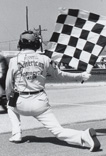 Duke Pennell was a tireless AMA racing official who spent his entire adult life officiating AMA races. Pennell is best known for being an AMA starter for better than 50 years. He flagged nearly every major AMA national race from the late 1940s to the late 1990s.
Duke Pennell was a tireless AMA racing official who spent his entire adult life officiating AMA races. Pennell is best known for being an AMA starter for better than 50 years. He flagged nearly every major AMA national race from the late 1940s to the late 1990s.
Pennell brought a unique flair to his position. Instead of wearing the traditional white starter clothes, Pennell was the first to wear colorful tailor-made outfits that added a splash of color to the race meets. His wife, Bee Gee, made most of the flags Pennell used during his career. She also worked for over 30 years at AMA headquarters. In 1987, the Pennells were presented the prestigious Dud Perkins Award for their dedication to motorcycling.
Pennell was born in Athens, Ohio, on February 10, 1921. When he was 17, a friend offered to sell Pennell his Harley-Davidson for five dollars. Pennell didn’t have the money, so his buddy gave him the bike anyway and let him pay it off over time.
"I paid a quarter here and nickel there," Pennell remembered with a smile.
Pennell joined the local motorcycle club in Athens and began working as an assistant at the club-sponsored local AMA races. His first job was working as pit steward for local half-mile races in Athens in 1939.
During World War II, Pennell served in the Army Air Corps in the South Pacific. When the war was over, he and Bee Gee settled in Columbus, Ohio. Pennell took up racing himself. In fact, he recalls spending his honeymoon at a race meet in Lancaster, Ohio.
Pennell suffered a crash at a race in Dayton, Ohio, in October of 1949, resulting in extensive nerve damage to his left side. The accident left Pennell’s left arm immobile, but that didn’t deter him from racing. Even though he gave up flat track racing, Pennell still competed for years in off-road enduros.
"I moved the clutch over to the right side of the handlebar, along with the front brake, and propped my left hand on the bar and rode," Pennell said matter of factly. "Every once in awhile, my left arm would fall off and I would have to stop and put it back on the bar."
Pennell became AMA district referee Joe Gee’s assistant in the early 1950s. Under Gee, Pennell served about every function as an AMA race official from timing and scoring, to referee to starter. Pennell also worked with legendary racer Jim Davis, who became the AMA chief starter after his racing career. Pennell cites Davis and Indy 500 starter Pat Vidan as major influences in his career.
"I was smart enough to copy some of the things they did," he says.
Pennell’s real job was an administrator at the Columbus Police Department. His job was perfect in that he had 30 days of vacation per year. He used most of that vacation traveling to the races all across the country. In addition to serving as starter, Pennell also drove the AMA equipment transporter to the events. He worked all types of events from flat track to road racing to motocross.
Pennell developed a unique style of flagging. Once, a photographer told Pennell he could never get a photo of him with the checkered flag fully displayed. So Pennell worked on a technique of cocking his wrist at a particular angle that allowed for the flag to be fully unfurled as he waved it. He also learned to be incredibly still before flagging the start of a race.
"Riders would study a starter and find little giveaways that they were going to drop the green flag," Pennell explained. "Once a rider came up to me and said he could always get the jump on me because I dipped my knees just before I dropped the flag."
Pennell worked in all kinds of conditions, flagging races in heat, cold, rain, dust and once even in snow at a race in Florida of all places. He recalled some of the more humorous moments as starter. Once he waved the flag to start a race and the flag flew off the pole.
"I always kept my thumb on a piece of the flag material after that," he said.
Another time, a European racer had a big lead, but pulled into the pits after getting the white flag.
"His crew asked him what was wrong," Pennell recalls. "He said, 'Nothing, they threw the flag.' In his country, they didn’t throw white flags to signal one lap to go and he thought the race was over."
In addition to the often tough conditions and long days as a starter, Pennell also experienced some close encounters with the speeding racers. In one race, two riders battling for the win took odd lines exiting the final turn and one rider zipped underneath Pennell as he waved the checkered flag while the other went around him on the outside.
Pennell began starting before the era when radios were used to communicate with the corner workers.
"You look back on it and wondered how we managed without radios," he said. "That was a big improvement in the safety of the races when we started using radios."
Pennell’s wife, Bee Gee, passed away in 1990 and he retired to Florida a few years later. He lived just a few miles from Daytona International Speedway and took up golf in retirement. Even using just one arm, Pennell was proud of the fact that he occasionally could get 150 yards on a drive off the tee.
Pennell died on December 2, 2007.